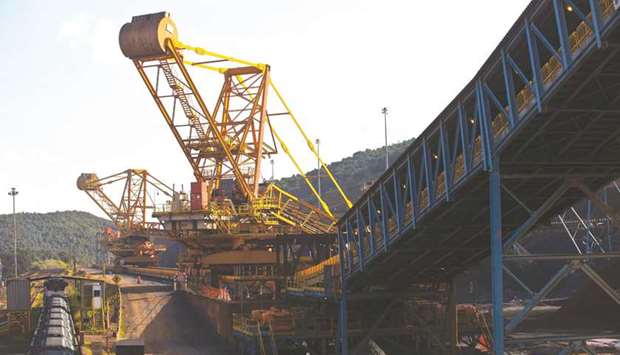
Crushed iron ore fills cargo train wagons aside a conveyor belt at Vale’s iron ore Brucutu mine (file). Iron ore has spiked after Vale suffered from a dam burst in January and announced cuts of up to 70mn tonnes, although some of that drop can be offset.
The global iron ore market is looking to Rio Tinto Group to see whether the miner will be adding more supply following the losses suffered by Brazil’s Vale SA, after two of the industry’s other heavyweights said this week that they’re not in a position to boost production substantially.
“We’re seeing the possibility of additional supply from Rio, not as a response to the Vale accident per se, but just as a source of extra tons versus last year,” Andrew Gadd, senior analyst at CRU Group’s Sydney office, said by phone on Thursday.
“The majors including Rio are not going to be in a position to respond specifically to the accident in Brazil.” Iron ore has spiked after Vale suffered from a dam burst in January and announced cuts of up to 70mn tonnes, although some of that drop can be offset.
The jolt to the seaborne market has prompted speculation that there could be a shortfall this year even as the higher prices induce others to step in. Still this week, both BHP Group and Fortescue Metals Group – which along with Rio and Vale dominate the trade – said they can’t ramp up.
“Over the medium term, we were already looking at a market that was oversupplied,” Paul Butterworth, CRU’s research manager for steel raw materials, said from Singapore. “Now, whoever was likely to withdraw won’t need to, and there can be a response from China, a response from India.
And one or two projects around the world might be more viable.” After the disaster on January 25, which killed more than 150 people and ignited an industry rethink about how to manage operations, prices rallied, then gave up some gains. Futures on the Singapore Exchange hit $94 a tonne on February 8, the highest price since 2014. The most-active contract was at $84.32 on Thursday.
Rio Tinto, the world’s no 2 producer, is due to report earnings, offering executives an opportunity to comment on the company’s position and market outlook. In January, days before the Vale tragedy, Rio said it aims to raise annual iron ore shipments about as much as 3.5% in 2019, forecasting sales of between 338mn and 350mn tonnes from Australia.
Goldman Sachs Group Inc has said that Rio is likely to be the only major producer that’s able to substantially increase volumes. Macquarie Wealth Management said while over the medium term Rio has the greatest flexibility to lift production, that would require a significant increase in capital.
No Additional Capacity There won’t be more from BHP and FMG. “We don’t have any additional capacity to put into this market,” BHP chief executive officer Andrew Mackenzie said on Tuesday. “We maximise the production from what we have already installed, we are not holding anything back.” BHP forecasts output, including for third parties, of as much as 283mn tonnes in the year to July.
Fortescue, which expects to ship 165mn to 173mns tonnes this fiscal year, also doesn’t have near-term ability to raise output. “Sitting here today, we don’t have the capacity currently for a material increase into the market in the short-term,” chief executive officer Elizabeth Gaines said. CRU’s Butterworth, who has about a quarter of a century of experience in the steel industry, said: “Essentially, what we’re doing with Rio is to move our view from the bottom of their production guidance to the top.”
Other smaller miners may also chip in. “There’s no way overall to make up the loss in volumes completely,” said Tomas Gutierrez, an analyst at Kallanish Commodities. “It’s worth noting that all these miners are incentivised to max out volumes. Some smaller miners may also restart.”
